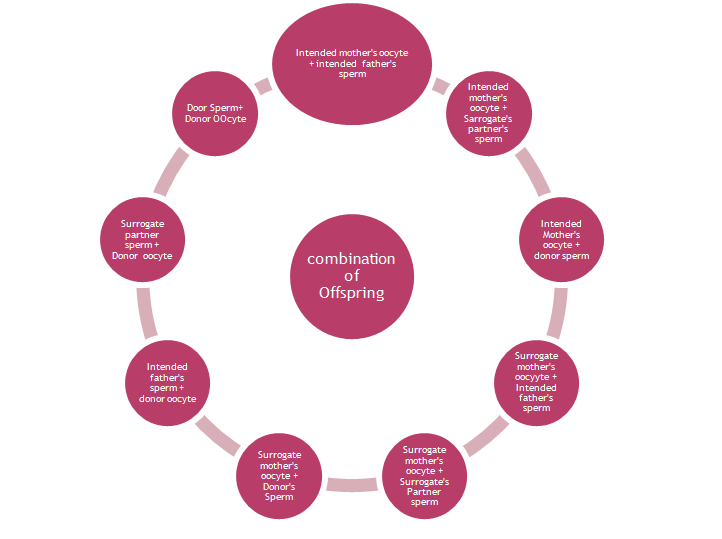There are various possibilities associated with surrogacy.
In the past, there was a possibility of genetic surrogacy, in which oocyte is collected from a surrogate mother.
However, nowadays this practice became redundant and outdated.
In its place, gestational surrogacy in which the surrogate’s oocyte is not used to create the embryo came into practice.
In surrogacy, the primary concerns are – what are the sources of gametes and their possible combination to create the embryo.
Below are different combinations that are possible to create an embryo in the surrogacy process:
- The used gametes (both sperm and oocyte) were collected from intended parents.
- Either sperm or oocyte is collected from a sperm donor or egg donor.
- Both the used gametes (sperm and oocyte) were collected from a donor.
- Sperm from the intended father combined with the surrogate oocyte.
- Donor sperm combines with the surrogate oocyte.

Combination of Offspring
- Intended mother’s oocyte + intended father’s sperm.
- Intended mother’s oocyte + Sarrogate’s partner’s sperm.
- Intended Mother’s oocyte + donor sperm.
- Surrogate mother’s oocyte + Intended father’s sperm.
- Surrogate mother’s oocyte + Surrogate’s Partner sperm.
- Surrogate mother’s oocyte + Donor’s Sperm.
- Intended father’s sperm + donor oocyte.
- Surrogate partner sperm + Donor oocyte.
- Door Sperm+ Donor OOcyte.
Some countries may not readily accept the combination in which the intended mother’s gamete cannot be used.
Surrogacy is a new reality, in which parenthood does not depend solely upon chromosomes.
However, whatever the combination be chosen for a surrogacy arrangement, the crux is that the infertile couple chooses that option as a solution for their problem.
Doing this, they take time to think of the family pattern, which is suitable for them.
Usually, these couples do not have the option to access other assisted reproductive techniques and also do not have the alternative motive to adopt a child.
Surrogacy clinics properly screen and evaluate the psychological perspective of intended parents before perusing surrogacy.
From a psychological perspective, the relationship of this third party parenthood practice has three specific psychological or social conditions which largely based on who can avail of this procedure, how it psychologically affects the individuals who are involved in the surrogacy arrangement, and the long term effect on the family and the offspring.
In this assessment, many couples can also get rejected if it results in finding psychological issues associated with any of the intended parents.
There is very limited information available to evaluate the family condition when different combinations are used in surrogacy to build a family.
But, the available data stated that the families that are built through surrogacy had good family functioning and satisfactory development of children born to surrogate mothers in comparison with a sample of families who had conceived using natural methods.
However, the included families in the research studies had too young children, and therefore difficult to evaluate the long-term effect of these families.
But it has been found that the intended parents had tried to maintain the secrecy from their children in case they were born through donated gametes.
Disclosure of such cases from other sources leads to family issues between parents and children.
In most of the cases, the families who had availed ARTs are usually least bothered about genetic links or the mother-child relationship but they are more concerned about fulfilling their desire to have offspring, which may gestate in another uterus.
Read Also:

Ravi Sharma is a self-motivated, successful entrepreneur and has a solid experience in the fertility segment. and he is the director at ARTbaby Global (ARThealthcare). He is a pharmacy graduate with post-graduation in business administration and has 14 years of rich experience in the field of infertility segment. He loves to write about IVF, Surrogacy, and other ART (assisted reproductive technology) news, issues, and updates. He is a Pharmacy graduate (B. Pharm) and M.B.A (marketing).
His most recent success includes the successful launch of the medical tourism company, ARTbaby, which offers treatment options for infertility, egg donation, and surrogacy. He likes spending time with his family and writing about various aspects of IVF surrogacy and donating eggs.
